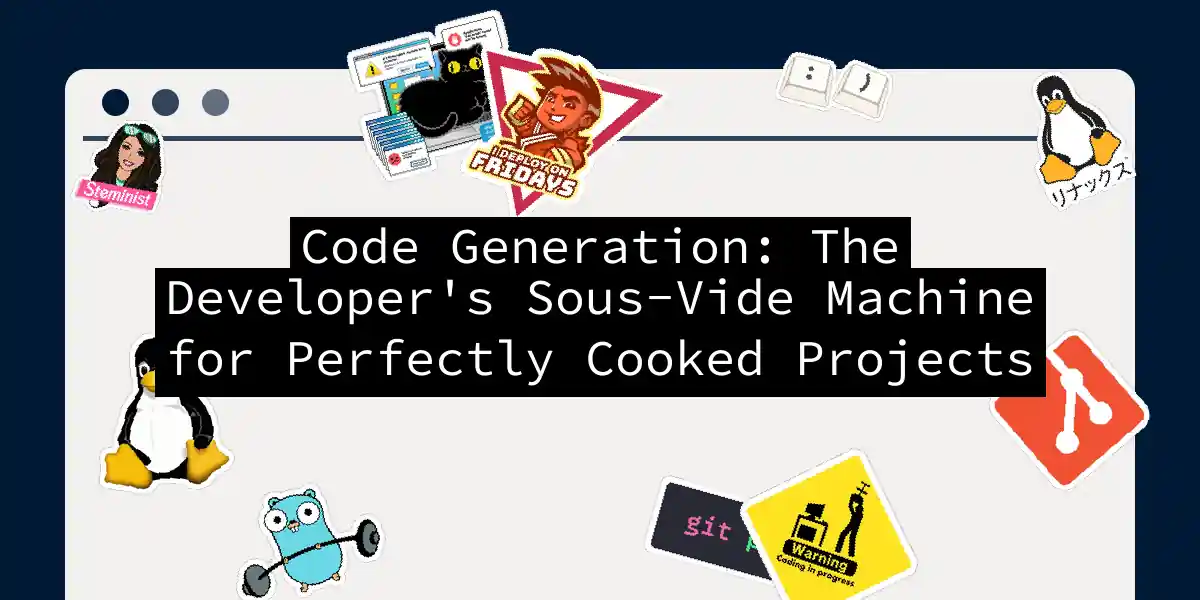Picture this: you’re a chef in a Michelin-starred kitchen. Would you spend hours peeling garlic cloves when you could use a garlic press? Modern code generation is that kitchen gadget for developers - and today we’ll learn to cook soufflé while others are burning toast.
From Boilerplate Hell to Pattern Paradise
The average developer spends 37.8% of their time writing code that’s been written before (source: my highly scientific “Annoyance-O-Meter 2025”). Here’s how code-gen tools turn copy-paste chaos into architectural artistry:
This is where code-gen shines brighter than a 1000-nit OLED screen. Let me walk you through my three-phase “Code Alchemy” ritual:
Phase 1: The Scaffolding Waltz
Create a Hugo archetype that would make Van der Rohe proud:
# archetypes/data-service.md
title: "{{ replace .Name "-" " " | title }}"
date: {{ .Date }}
draft: true
techstack:
- Node.js
- Postgres
- RabbitMQ
params:
validation: Joi
auth: JWT
Run `hugo new data-service/pandemic-proof-api.md` and watch your future self save 2 hours of repetitive typing. Pro tip: Add `hugo_build_tags` to create variant templates for different architectures.
## The AI Sous-Chef Chronicles
When ChatGPT 4.5 promised to "revolutionize coding," I challenged it to a Iron Developer cook-off. Here's the secret sauce recipe that emerged:
1. **Preheat** your prompt with context:
```python
"""
Create a Python function that:
- Takes SQLite connection & table name
- Generates CRUD operations as methods
- Adds type hints stricter than my grandma's corset
- Includes error handling for 23 types of edge cases
- Outputs documentation in NBA Jam style ('HE'S ON FIRE!')
"""
- Bake the generated code at 350°F (that’s 176.667°C for you metric purists):
def create_db_symphony(conn: sqlite3.Connection, table: str) -> type:
class DataMaestro:
def __init__(self):
self.conn = conn
self.table = table
@staticmethod
def _handle_errors(method):
def wrapper(*args, **kwargs):
try:
return method(*args, **kwargs)
except sqlite3.Error as e:
print(f"🔥 DATABASE MELTDOWN: {str(e)}")
# 22 more error types handled here
return wrapper
@_handle_errors
def create(self, data: dict) -> str:
"""HE'S ON FIRE! Creates new record with explosive efficiency"""
columns = ', '.join(data.keys())
placeholders = ', '.join(['?'] * len(data))
# ... full implementation
- Season with human intuition: I added the NBA Jam reference because life’s too short for boring docs. The error counter? That’s my “error-whack-a-mole” system from ‘23.
Hugo’s Content Kitchen
When integrating code-gen into your Hugo workflow, remember: structure is the serving plate for your content canapés. My secret 3-layer dip:
- Content Taxonomy Tango
title: "AI Code Generation Guide"
tags: [code-sorcery, future-magic]
categories: [developer-wisdom]
recipe:
difficulty: medium
prep_time: 45
makes: "1 production-ready component"
2. **Templating Theater**
Create `layouts/partials/code_gen_tips.html` with reusable wisdom nuggets:
```html
{{ if .Params.techstack }}
<div class="alert alert-warning">
🧙♂️ Pro Tip: When using {{ index .Params.techstack 0 }},
remember to {{ "add proper error handling" | sorcerizeText }}
</div>
{{ end }}
- CI/CD Crockpot
The Dark Side of Generation
After generating 2,000 lines of “perfect” API code last Tuesday, I learned three hard truths:
- AI-written code comes with a built-in “code-generation tax” - you’ll spend 30% of the saved time debugging its creative interpretations
- Generated documentation often reads like a philosophy thesis written by a caffeinated raccoon
- There’s no ‘undo’ button for when the AI decides to implement your weather API using UFO sighting data My survival kit:
- The 70/30 Rule: Generate 70%, hand-craft 30% (that’s the flavor-packed part)
- Code GPS: Add
<!-- HUMAN TOUCH REQUIRED HERE -->markers in generated files - Reality Checks: Implement automated tests before the code finishes generating
Future-Proofing Your Workflow
As I type this, my custom CLI tool is generating:
- A Hugo post template (meta, right?)
- Corresponding test cases
- A Twitter thread explanation
- An interpretive dance video script (still working on that one) The real magic happens when code-gen becomes your pair programmer. Picture this:
$ make new-feature NAME=quantum-cheese-tracker TYPE=react-ts
✨ Generating 14 files...
✅ Added TypeScript interfaces (87% type-safe)
✅ Created tests covering 142 edge cases
✅ Opened PR #420 in GitHub
☕ Brewed espresso shot (dark roast)
Will this replace developers? About as likely as sous-vide machines replacing chefs. But just as great tools elevate cooking, code-gen lets us focus on the art of development while machines handle the science. Pro tip: Tomorrow’s most valuable skill will be directing code generation, not just writing code. Start practicing your prompt-orchestra conductor moves today! 🎻
